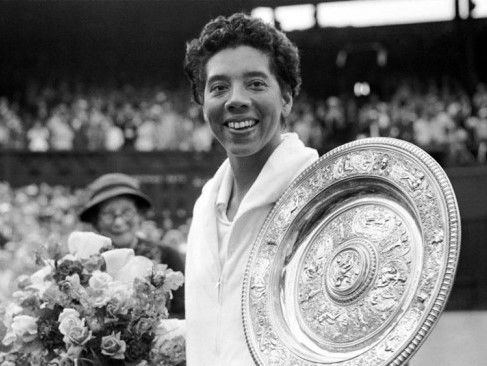Three Years After Jackie, Althea
Three years after Jackie Robinson broke baseball’s racial barrier, another athlete who was born into a family of southern sharecroppers cracked open the U.S. National Championships, forerunner of today’s U.S. Open.
Sixty-seven years ago this week, Althea Gibson became the first tennis player of color to swing a racket at the Nationals. Having built a winning portfolio with the American Tennis Association (ATA) and granted entry to compete at an all-white tennis club, the 23-year old subsequently made her debut in Forest Hills on August 28, 1950.
Founded in 1916, the ATA was the tennis version of the Negro League, black America’s answer to the practice of banning African-Americans from competing alongside whites.
But tennis was different. Entering the Nationals was not the same as breaking into a mass-consumption pastime sport like baseball. A mostly unpaid recreational pursuit, lawn tennis embodied the added hurdles of money, class and status.
Gibson’s initiation was more historic than triumphant. She lost in the second round of her inaugural tournament to the #3 seeded Wimbledon titlist, Louise Brough. It would take a half-dozen years and plenty of frustrations before landing her first trophy at the 1956 French Open.
What followed were two consecutive seasons of victories at Wimbledon and the U.S. Open. By the end of her amateur career in 1958, she would clinch 5 singles grand slams.
Gibson was the first black champion in Wimbledon’s 80-year history and the first to receive the trophy personally from Queen Elizabeth II. She remarked that shaking hands with the monarch “was a long way from being forced to sit in the colored section of the bus”.
The tennis prodigy also stormed the doubles scene. In addition to a playing partner, Gibson found a soul mate in Angela Buxton, a Jewish tennis virtuoso who herself ran up against discrimination in her native England.
Together, the pair captured the doubles competitions at the French Open and at Wimbledon in 1956; the feat was as much a bold statement in the face of the elite tennis world as it was an athletic achievement.
Gibson was named Female Athlete of The Year by AP in 1957 & 1958. “Sports Illustrated” and “Time” both had her on their front covers, the first black woman to be featured.
Though born in the South, young Althea grew up in Harlem and started drawing attention after winning paddle tennis matches. A cadre of upper class black professionals took over and provided training and guidance. Boxing champ Sugar Ray Robinson was one of her patrons.
At the time, players qualified for the Nationals by accumulating points at sanctioned tournaments, most of which were by invitation and held at private white-only clubs.
The unlikely tennis star, who was born in a rural shack and brought up on the streets of New York, was groomed with the necessary grace and elegance expected of ladies on the tennis court.
But it wasn’t until Alice Marble, a 1930’s American tennis celebrity, published an indicting article against the sport’s policy of segregation, that Gibson was allowed entry.
In July, 1950, Gibson received an invitation to the Eastern grass court championships at the Orange Lawn Tennis Club in South Orange, NJ. Her performance there was good enough to win a bid to Forest Hills.
And the rest as they say, is history.
Other articles enjoyed: Arthur Ashe: Personal Essay, Wimbledeon: Sporting Tradition, American Men In Tennis: Gone, Boxing Champ Jack Johnson & White Women










